Collective Voices, George Caleb Bingham Gallery (2020)
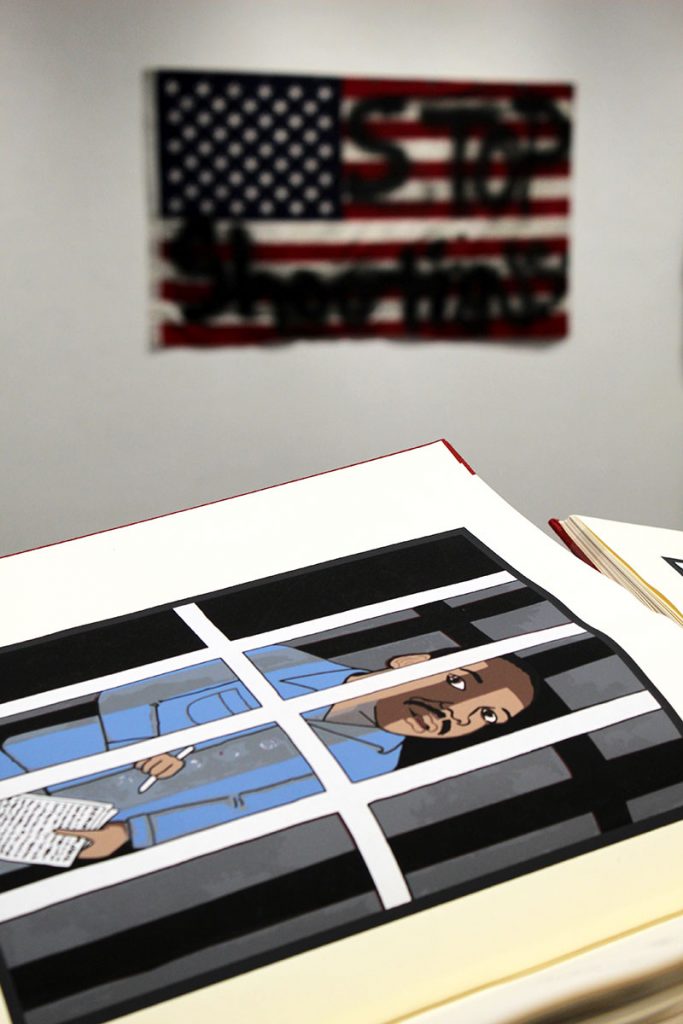
Collective Voices
October 2 – November 19, 2020
George Caleb Bingham Gallery, Fine Arts Building, University of Missouri
Collective Voices includes art, archival, and textile objects from three campus collections – Missouri Historic Costume and Textile Collection, University Archives, and Special Collections – that reveal historically repeating narratives relevant to today: marginalized voices, Mizzou student activism, thoughtful citizenship, civil rights, political tensions, and climate & environmental concerns. These accounts, while simultaneously local, national and global, emerged as common themes shared across time. This exhibition is a gathering of these persistent narratives and an acknowledgement that so many voices still need representation and amplification within our campus collections and across cultural institutions.
Curated by Catherine Armbrust of the George Caleb Bingham Gallery, John Fifield-Perez of University Libraries Special Collections and Nicole Johnston of the Missouri Historic Costume and Textile Collection. Explore more exhibit objects from Special Collections.
Virtual Exhibition Tour, Part 1
Virtual Exhibition Tour, Part 2
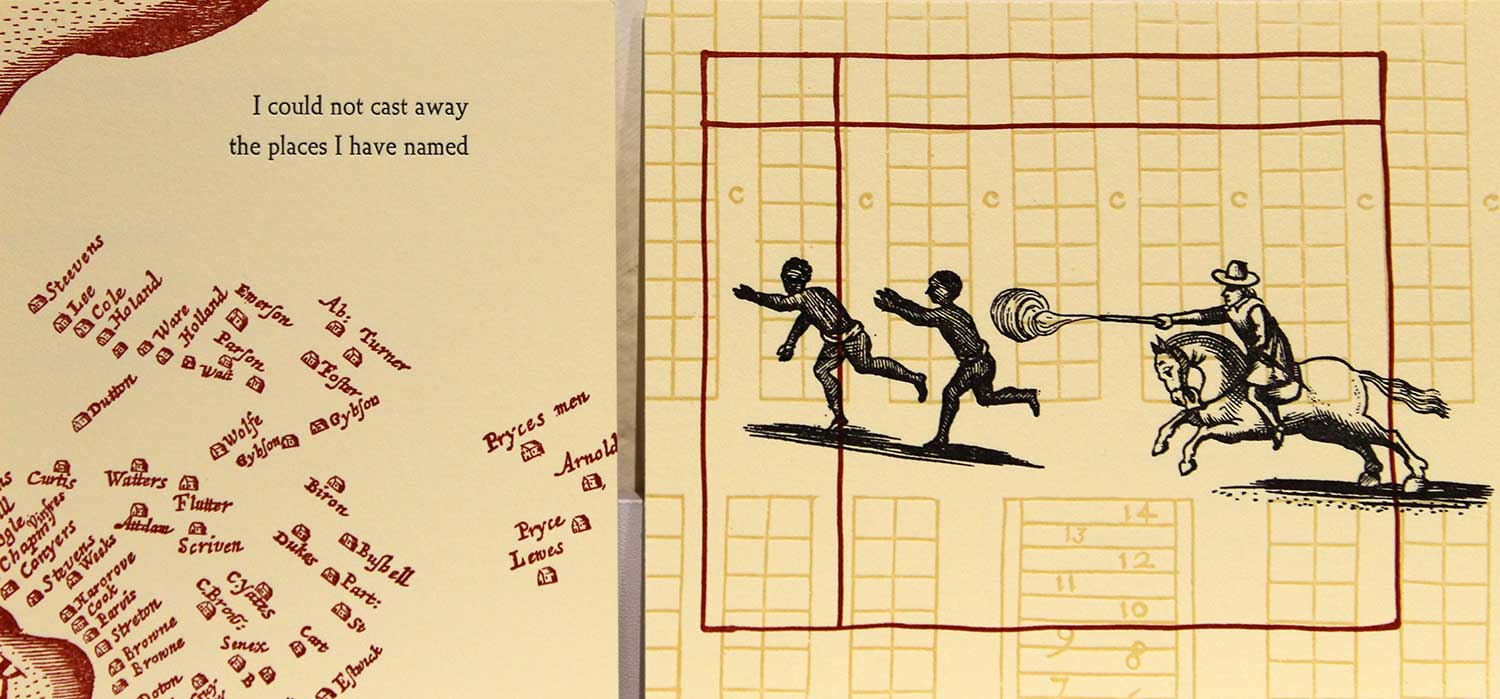
VOICES OF ANTI-COLONIALISM

A True & Exact History by Sonia Farmer
2018
Letterpress
Ellis Library Special Collections
“A True & Exact History (Poinciana Paper Press, 2018) is an erasure of one of the most formative descriptions of the English Caribbean in the seventeenth Century, Richard Ligon’s 1657 guidebook, A True and Exact History of Barbados. Using the language, imagery, and thematic drives at the core of this text to disrupt the teleology of colonial Caribbean history, these unbound poetic fragments scattered among a shifting landscape simultaneously re-create and resist narrative as a device of cohesive history, ultimately calling into question what it means to write “a true and exact history” of anything. Untethered to linearity, the book can be encountered in multiple displays and formats, including as a sound piece.” (adapted from the artist’s statement)
The Middle Five: Indian Boys at School by Francis La Flesche (1857-1932)
1901
Ellis Library Special Collections
Francis La Flesche was the son of E-sta-mah-za (also known as Joseph LaFlesche), the last Head Chief of the Omaha tribe. La Flesche rose to prominence as an ethnologist and advocate for Native Americans. he specialized in the study of the Omaha and Osage tribes, collecting their folklore and recording their songs and rituals on wax cylinders, kept today at the Library of Congress. As distinctive Native American ethnologist, La Flesche spent decades studying the Osage and recording their religious practices, emphasizing the complexity of their culture and arguing against patronizing notions of Native Americans as a simpler, less complicated people. He was the first Native American to become an anthropologist and his work on indigenous music remains relevant into the twenty-first century. His memoir, The Middle Five: Indian Boys at School, reflects on his education at a mission school in the 1860s, providing a rare account from a Native American’s perspective of the kind of education promulgated by white Americans. (adapted from Special Collections website)


The Square by Islam Aly 2014
Laser-cut paper, laser-etched oak boards
Ellis Library Special Collections
“Egyptian uprising called for democratic reform. Tahrir Square in Cairo became the focal point and the most effective symbol of the protests in January and February 2011. For 18 days Egyptians repeated the slogan: The People Want to Bring down the Regime (al-shàb yurid isqat al-nizam) until the regime stepped down on the 11th of February 2011. This book focuses on the revolution slogan ‘al-shàb yurid isqat al-nizam.’ Cairo’s map is laser engraved on the book covers. Three edges of the book are colored then laser engraved to show the streets of Cairo.” (adapted from the artist’s statement) Using Arabic Kufic script the words of the slogan are repeated in an ascending sequence. The last section contains the time and date when the regime stepped down along with the sentence ‘Al Saa’b Askat al Nezam’ with its English translation ‘The People have Brought down the Regime’.

University of Missouri Savitar 1996 Ellis Library Special Collections LH1 .S2 v.102
Images on these two pages reflect what may have been the first powwow at the University of Missouri. “Dancers and musicians from Oklahoma, Kansas, Illinois, Tennessee, and other states traveled to participate in the powwow. The event featured a dance competition, Native American food, and arts and crafts booths. “A lot of universities have powwows, and MU didn’t. We thought it would be a good educational experience for the university,” junior Travis Willingham said. “The powwow is a modern celebration of our Native American heritage and an opportunity to teach others.”We did not see the student turnout we had hoped for. It was also quite disappointing that school administrators did not attend the event,” senior Kent Blansett said.”

CIVIL RIGHTS VOICES
“Stop Shooting U.S.” Spray-Painted American Flag
Gift of C. Bell
2020
MHCTC
As a coordinator of the student-led MU campus protest and solidarity march on May 31, 2020, the donor used this American flag to visually communicate his support of the equal justice march that began and ended on the MU campus. This action was in direct response to the murder of George Floyd and the continuation of police brutality against Black people across the nation. Hear the donor speak about the motivation behind the creation of this flag in the Virtual Exhibit Tour Part 1 beginning at 1:14:17.
“When I made this flag, it was in the midst of the whole George Floyd and the Brianna Taylor situation. It spoke a lot to me, being a young Black man; I’ve had guns pulled on me by police since I was twelve- thirteen years old, however old you are in seventh grade… With a lot of that, you’re just seein’ how, as I grow up, here we are eight years down the line… and this is still happening. In some cases it’s not like where the guns get put up, put away, and things like that; people actually lose their lives. So, that’s kinda what really meant the most to me with this flag.” – Christian Bell, October 26, 2020

Danger: Educated Black Woman Armed With Knowledge T-Shirt Gift of K. Caldwell 2017-20 MHCTC
MU Senior Kaija C. wore this t-shirt as a coordinator of the student-led protest and solidarity march on May 31, 2020 that ended and began on the MU campus. As one of few black female students in MU’s College of Agriculture, Food and Natural Resources, Kaija recently discussed her personal experiences at Mizzou with President Mun Choi in response to #BlackatMizzou. These experiences, as well as growing up in the food desert of south side Chicago with a family member who participated in the American civil rights movement of the 1960s, motivate Kaija’s current activism. “I have nieces and nephews,” she expressed. “I have to leave them something.“ Hear the donor discuss the motivation behind her current activism in the Virtual Exhibit Tour Part 1 beginning at 40:00.

May 31, 2020 March, Photograph by Leanne Tippett-Mosby 2020 Collection of Tippett-Mosby
Both the t-shirt and American flag pictured here coalesce in “real life” in this photo by Leanne Tippett-Mosby for the Columbia Missourian. “Christian Bell, Kaija Caldwell, and Ashton Brown organized a solidarity march [on May 31, 2020] on MU’s campus. After marching through downtown, protesters returned to the statue of Thomas Jefferson on the MU Quadrangle. Organizers held [the flag seen next to the photo] in front of Jefferson’s statue while Caldwell urged the crowd to contact university officials to have the statue removed, noting Jefferson’s history as a slave owner.” (text courtesy of Columbia Missourian) Hear discussion of this protest on the University of Missouri campus in the Virtual Exhibit Tour Part 1 beginning at 40:45.
“I was saving [this shirt] for the right moment. The day of the protest… I was talking with some friends … there was a lot going on, a lot happened that week, the whole country was protesting… and we just wanted to figure out a way that we could contribute. Columbia is such a small town but we’re all from some large urban cities where the stuff that was going on at our homes felt close to heart, and we wanted to see what are some of the things we could do? What can we do to get our voices heard? We’re paying attention to what’s going on too… and we need to let the community know that this is an issue that expands beyond major cities…
… It’s beyond politics; it’s life or death now. Being in college I’ve been exposed to a vast majority of different people… and I feel that is something else that has contributed to my knowledge, not just the books, not just the classes, but the experience of the people. I felt like, at that point, I was armed with everything I needed to be able to be a voice for people. I felt like at that point, I’m a danger; you better watch out, ‘cause I’m coming through! This is… why I wore that shirt that day.” – Kaija Caldwell, October 26, 2020

Cotton Face Mask with “Black Lives Matter” Print (2020) MHCTC
Few objects in fashion history reveal as unique a story as that of the 2020 face mask. This particular mask visually communicates the merging of two pivotal moments in world history – the Covid-19 pandemic and the Black Lives Matter equal justice movement – resulting in a distinctive dress element rife with purpose.

Savitar (1992) Ellis Library Special Collections LH1 .S2 v.98 1992
The shooting of Rodney King by police in St. Louis, Missouri in 1992 led to civil rights and equal justice marches and protests both on campus and throughout Columbia, including directly in front of the Columbia Police Station where similar equal justice and Black Lives Matter marches occurred throughout the spring, summer and fall of 2020.
Enough is Enough Cotton T-Shirt by Kayla Hahn
Hand-Stenciled and Bleached Cotton
2020
MHCTC
“After becoming aware of Columbia’s equal justice movement in spring 2020, MU Senior Kayla Hahn began attending protests downtown and on campus where she immediately noticed very few ways to visually identify participants without signs. In response, Hahn began creating her t-shirts and handing them out at events. Each hand-cut stencil design was pieced onto the shirt in combination with bleach splattering and spraying. Hahn describes the t-shirts as her way of being “a part of history rather than just learning about it.”

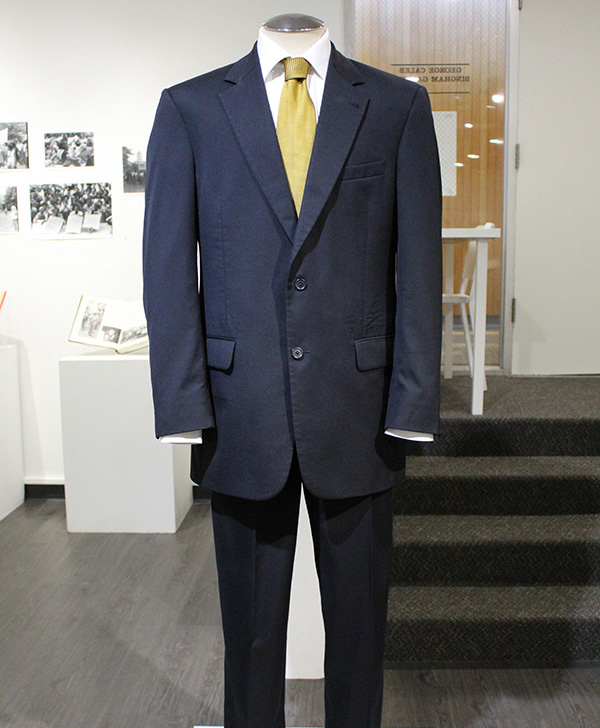
Suit Ensemble of Michael Middleton, Wool, Cotton, Silk (2000s) MHCTC
Michael Middleton was the third Black student to graduate from the University of Missouri’s School of Law (JD, ‘71.) During his time as a student at Mizzou, Middleton was a founding member of the Legion of Black Collegians, and as such, presented a list of student equity and justice demands to the MU President in 1969. After graduating in 1971, Middleton maintained an illustrious career with the federal government. Middleton began his tenure at the University of Missouri in 1985 as the School of Law’s first Black faculty member. In 1997 Middleton served as the Interim Vice Provost for Minority Affairs and Faculty Development, and as Deputy Chancellor from 1998 to August 2015. From December 2015 to March 2017 Michael Middleton served as Interim President of the University of Missouri system. During that time, he received a more recent list of student demands for equity and justice from Concerned Student 1950 in 2015. In 2020 the Michael A. Middleton Center for Race, Citizenship and Justice was named in his honor.
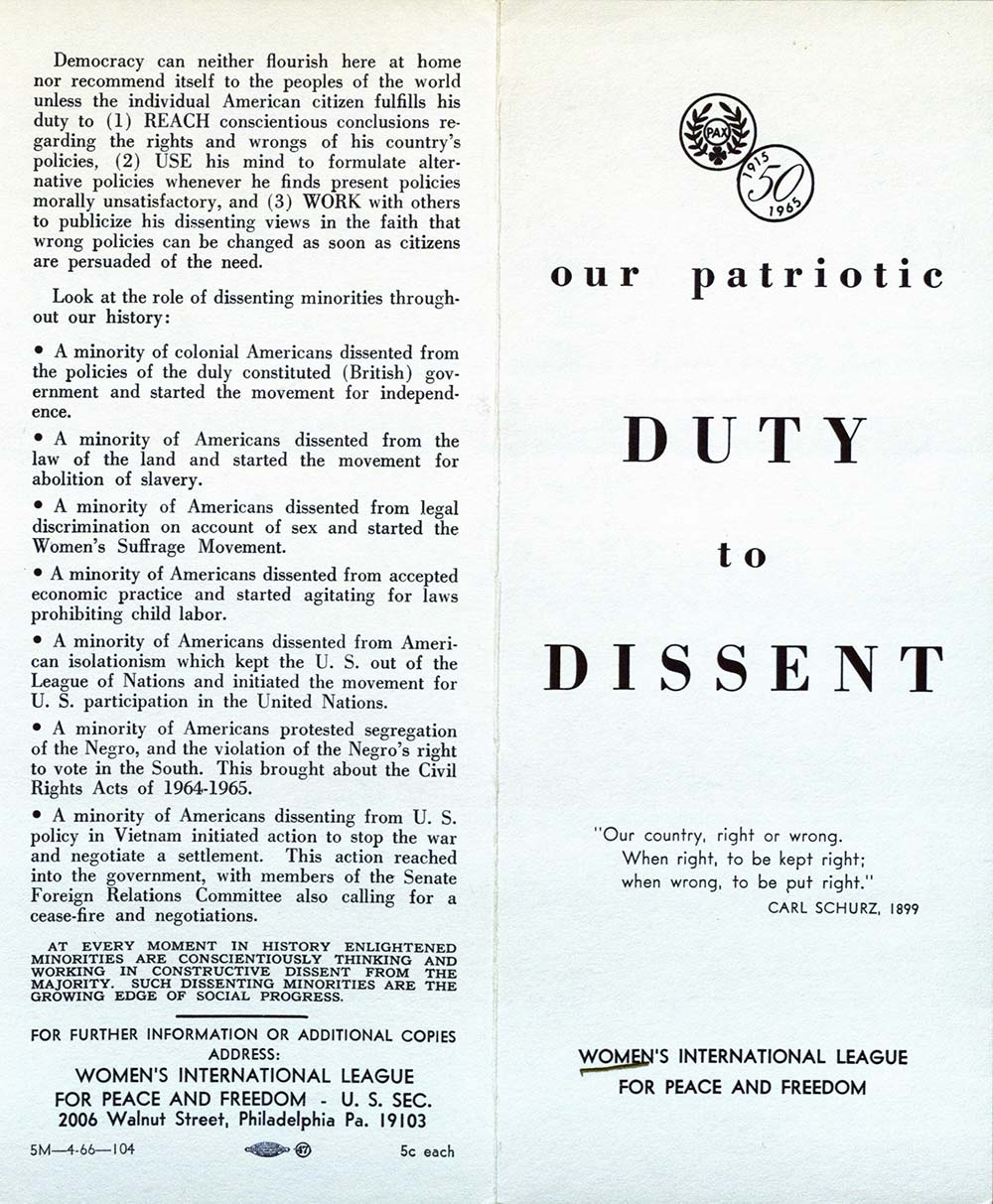
Our Patriotic Duty to Dissent Flyer by Women’s International League for Peace and Freedom n.d. Ellis Library Special Collections
“Our country, right or wrong, When right, to be kept right; when wrong, to be put right.” This 1899 quote by Carl Schurz featured on the front of the flyer, as well as the text throughout, speaks to dissent and is similar to the recent language on campus from the MU administration around dissent by faculty, staff and students and the presentation of dissent as a civic duty. In 2020, MU President Mun Choi discouraged dissent – publicly and in communication to faculty members – by faculty members, staff and students. President Choi later took responsibility for some believing he was attempting to “silence voices” and pledged to support free speech.
Missouri alumnus, volume 073, number 05 (Arvarh Strickland article pp16) 1985 May-June
This Missouri Alumnus Magazine excerpt discusses Dr. Arvarh Strickland’s educational philosophy in relation to Jeffersonian Principles shows and depicts him with the controversial Thomas Jefferson tombstone on the MU campus now protected by a $20,000 plexiglass box.
During his time at MU, Strickland was instrumental in the development of the Black Studies minor, now available as a major, to promote a broader perspective on America both in the past and present. His achievements during his time in Columbia are numerous. He and his family integrated the First United Methodist Church and he helped found the Guardians to help support African-Americans in the city. He additionally served on City committees, helped organize Black voters, and contributed to other organizations.


MU Savitar Campus Activism
This section of the exhibit included images from the MU Savitar in University Archives collections of the 1960s and 70s that depict moments of civil rights activism on the University of Missouri campus. Marches, rallies and sit-ins connect the past movement to that of today. Activists wear dashikis and black fist patches, while protesting with raised fists. The Savitars on display depict students placed on probation for demonstrating in 1968 —an event that resonates with student demonstrations in Fall 2020 when activists received academic sanctions for demonstrating inside Jesse Hall. Members of Delta Sig Omega Sorority pose in front of Confederate Rock on the MU campus in 1970. In 1971 MU students remember the murders of student activists at Kent State one year earlier. Similar to today’s equal justice movement, local activism often reflects national sensitivities. A binder was also provided for guests to peruse that included various archival documents regarding with MU’s Legion of Black Collegians and the 2015 student protest and hunger strike led by Concerned Student 1950, the latter of which included the List of Demands by CS1950 received by Interim Chancellor Michael Middleton who helped draft and present the first list of black student demands in 1970.
Letter from Birmingham City Jail by Faith Ringgold & Martin Luther King, Jr.
Serigraphy, letterpress
2007
Ellis Library Special CollectionsThe Limited Editions Club commissioned eight serigraph prints from artist Faith Ringgold to accompany King’s text in a fine press edition. Images include King in a jail cell, the 16th Street Baptist Church bombing by white supremacists, cotton laborers, the Montgomery Bus Boycott, police violence toward marchers on the Edmund Pettus Bridge, and pictured here, the suppression of protesters against voter suppression.Completely handmade, these two books contain text from the famous letter by Martin Luther King, Jr,. written while incarcerated in the jail in Birmingham, Alabama, and screen prints by Faith Ringgold that visually contextualize the events described in Dr. King, Jr.’s letter.This image of protesters interacting with police resonates strongly with not only other similar events depicted within this exhibition, but also with numerous protests in 2020.


ENVIRONMENTALISM
Bee Line by Michelle Bayer & Kyle Olmon
Cotton handmade paper, pigmented pulp, marigold seed, string, adhesive, letterpress printing
2010
Ellis Library Special Collections
Many flowers and vegetables owe their existence to pollinators like the humble honeybee. In the past few years we have seen the disappearance of the Colony Collapse Disorder. While disease, pesticides, or loss of habitat have contributed to the effect, no one is sure what is causing the mass death of bee colonies, but we will all feel their loss as agricultural and economic practices suffer. [The artists created] a card that speaks of delicate ecological and economic balance, as well as providing a means of hope. The marigold is a bee-friendly flower symbolically associated with both life and death around the globe. The card itself is plantable in order to grow marigolds and attract bees. (adapted from the artists’ statement)


Savitar (1991) Ellis Library Special Collections LH1 .S2 v.97
alludes to the period’s developing environmental consciousness as the U.S. celebrated its first Earth Day on August 22, 1970, a date often considered to be the birth of the modern environmental movement. Today, cotton remains one of the world’s most popular natural fibers but is one of the most environmentally damaging of those used in the apparel industry. It uses an enormous amount of water to grow effectively and an enormous amount of pesticide to “protect” it, thus having a damaging effect on groundwater and surrounding watersheds.

Log Cabin Quilt, Mixed media with cotton (1907-10) MHCTC
This pieced quilt features a popular log cabin pattern made of strips of a variety of fabric, including repurposed linens, shirts and suits. This Missouri-made quilt was pieced and sewn by the donor’s great-grandmother with the assistance of the donor’s father who helped cut the fabric strips. The repurposing (or upcycling) of materials, while most often done for economic purposes, can be considered an early form of environmentally conscious craft.
Save Our Pollinators by Amanda Lee
Laser-Cut Imitation Leather Honeycomb Skirt
2019
MHCTCMU Textile and Apparel Management student Amanda Lee created this laser-cut skirt as part of an ensemble titled “Save Our Pollinators” for a TAM 2380 Integrated Apparel Design and Production project related to the Missouri Historic Costume and Textile Collection’s 2019 exhibition Flora and Fashion. The skirt features a laser-cut honeycomb pattern inspired by Mizzou Botanic Garden initiatives Missourians for Monarchs and Restoring Bees and Pollinators.“Pollinators such as bees and butterflies contribute a great amount to our ecosystem. Unfortunately, there has been a world-wide decline in pollinators. This decline can lead to the death of all our plants and agriculture systems. These designs represent what will be lost when all of our pollinators die off. Without bees there will be no more honey produced.” – Amanda Lee


QUEER VOICES
Funny Ha Ha/Funny Peculiar by Emily Martin
Letterpress
2016
Ellis Library Special Collections
“This book(s) is the result of my extended study of Shakespeare’s comedies. I find the comedies individually to be enjoyable but there is a sameness to many of the plots that allows me to mix them up in my head. So much mistaken identity, gender confusion and various other contrivances while romping their way to a fifth act wedding or two. Even more problematic are the decidedly unfunny themes that are common in many of these same comedies such as hypocrisy, sexual harassment, intolerance, sexism, misogyny, and anti-Semitism.
I struggled for a long time to integrate all these ideas. I finally realized that what I needed to do was to address each aspect separately, thus a dos-a-dos book. Each side has its own focus and treatment. The characters are the same in both books. They are printed using the P22 Blox which are a set of modular shapes that can be interchanged to change the body’s posture and gestures. The P22 Blox allows the presentation of the characters as interchangeable as well. Funny Peculiar is a drum leaf book and presents selected lines from five plays delivered by characters on a stage set. Funny Ha Ha is a slice book allowing the viewer to mix and match the costumes and gender of the characters in a variety of postures.”
(adapted from the artist’s statement)


Savitar 1978 Ellis Library Special Collections LH1 .S2 v.84 1978
“After a seven-year battle with the University of Missouri, Gay Liberation finally won recognition as a campus organization in 1978. The Board of Curators denied recognition on the grounds that homosexuality was an “illness clearly involving abnormal behavior.” If the group was recognized, it might promote homosexuality.
After exhausting all avenues within the University system, Gay Lib sought relief in the courts [that] finally ruled that denial of recognition of the Gay Liberation Organization violated the members’ rights to freedom of speech and association, and equal protection under the law.” Excerpt from 1978 Savitar

The Essential Dykes to Watch Out For
Dykes to Watch Out For: The Sequel: Added Attraction! “Serial Monogamy”, a documentary
Alison Bechdel (1960- ) 2008 Ellis Library Special Collections
Alison Bechdel is an American cartoonist, who successfully published her serialized comics for years. She was born in 1960 and moved to Manhattan after college. Bechdel was repeatedly rejected from art school and worked in many publishing jobs before connecting to outlets and readers. Her work started as single drawings; one panel comics originally published in WomaNews in 1983. Dykes to Watch Out For evolved into multi-panel strips, spawning posters and other print media. Eventually, she was able to work as a cartoonist full time beginning in 1990, without requiring additional work to support herself. Both books on exhibit contain both color and grayscale artwork with humorous and emotional insight into the urban Lesbian community. Since publishing Dykes to watch out for, Bechdel has received many awards, including the Eisner award in 2007, was named a Guggenheim Fellow in 2012, a MacArthur Fellow in 2014, and appointed Vermont’s Cartoonist Laureate in 2017. In addition to her comic strip work, Bechdel also created several creative non-fiction comic works or graphic memoirs regarding her childhood, family dynamics, sexual orientation, and her father’s suicide. Some of these works were adapted for the theater.

Saw Palmettos Charles Theonia & Container Studios Mixed media 2018 Ellis Library Special Collections
“Saw Palmettos is a series of short poems about hormones, community, and the brain-time continuum. Three years ago, I started HRT. From the experiences of friends and the proliferation of transition narratives and timelines on YouTube and elsewhere, I knew what I could expect to happen, but I had no sense of how I would feel about my changing body and emotions. Mostly, I was sure that I was low-key petrified of losing my hair. A friend who knows about herbs told me to rub saw palmetto tincture into my roots, so for the 15 oily minutes every application took to set in and try to block my new testosterone from converting to DHT, I made a practice of writing, which I’ve always found difficult to do regularly. As I wrote, inhabiting the inherently-funny, embodied moment of sitting still, dripping wet, and trying not to worry about balding, I noticed that I was focused less on depicting particular stories or scenes in time, and more on questions and uncertainties that lingered unresolved. The poems were tracing anxiety and disconnection not back to their sources, where I could potentially understand and contain them, but through to what comes next. The shifting “you” addressed in the poems encompasses many different relations from partners to friends to aggravating community acquaintances (adapted from the artist’s statement.)

FEMINIST VOICES

But She’s a Star Sande Wascher-James 1998 Paper, fabric, acetate Ellis Library Special Collections
“The book is based on the concept that there are many women who are real “stars” because of who they are as people, but who remain unknown to the general public. Handmade and hand crafted with accordion-fold pages. Opens to form a circular carousel when the covers are tied back to back with silver ribbon. Covers and box made from hand-dyed fabric with metallic thread and appliqǔed with metallic fabric stars. Postage stamps of famous women were scanned in by computer onto the fabric along with pictures of unknown women; a star shaped piece of acetate with images is attached between each page.” (adapted from the artist’s statement)
Untitled by Miriam Londoño
Pigmented cotton and flax pulps
2007
Ellis Library Special Collections
Londoño’s work transforms words into paper, thus support and content become one. Here the artist writes women’s names in Spanish. Londoño believes names to be the most intimate part of our identities, while Spanish is her native language. These texts, with the play of positive and negative space, allow other readings to arise spontaneously, naming and renaming. (adapted from the artist’s statement)

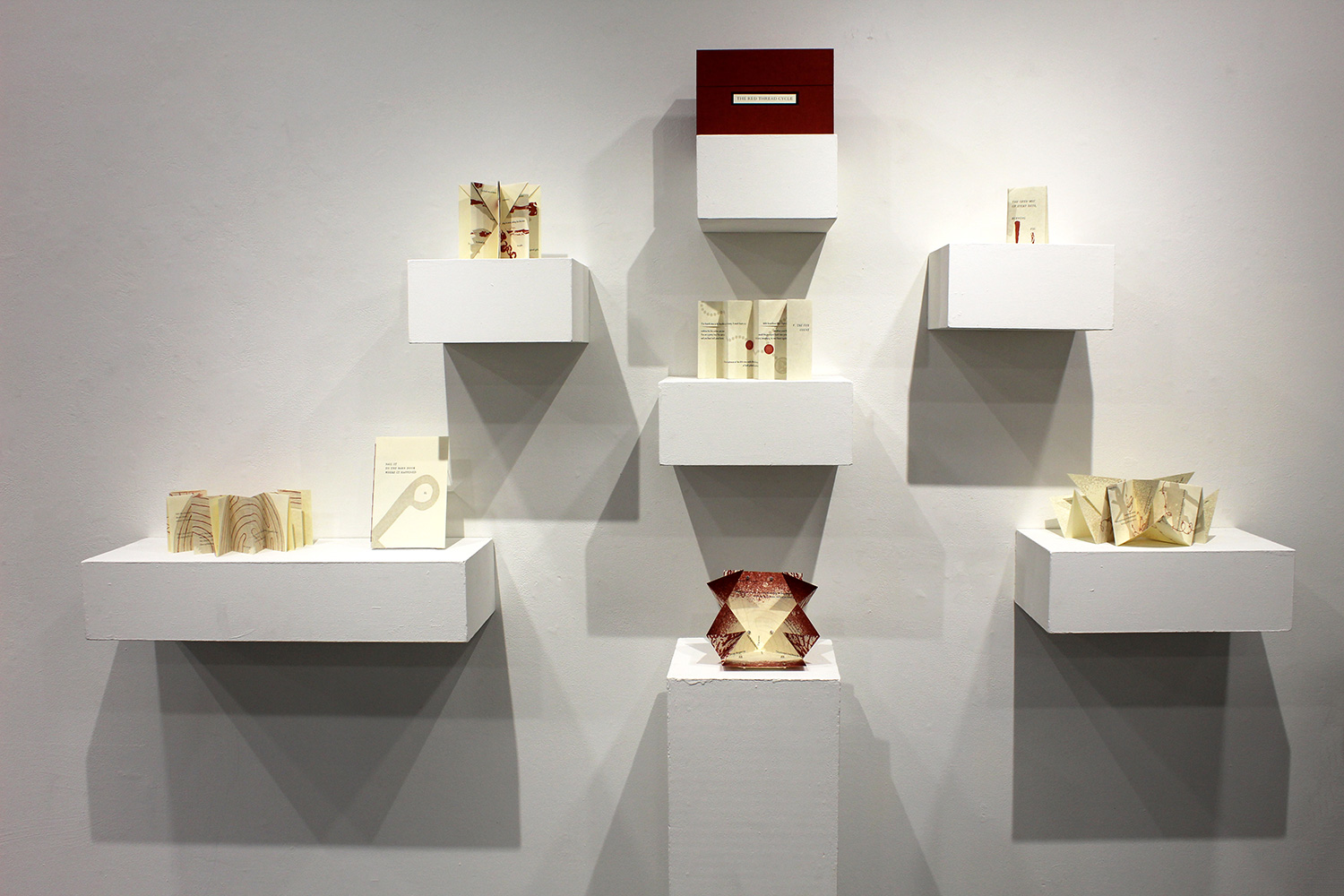
The Red Thread Cycle by Sonia Farmer & Shivanee Ramlochan
Pressure print, letterpress
2019
Ellis Library Special Collections
TW/CW: Sexual Assault
TRIGGER/CONTENT WARNING
“The Red Thread Cycle'” (2019) provides gut-wrenching witness to the realities of sexual assault in the Caribbean region. The starting point for this work is a series of seven poems by Trinidadian writer Shivanee Ramlochan that appear in her first book of poetry, Everyone Knows I Am a Haunting (Peepal Tree Press, 2017).
Presented as a rape kit, each book is stored in a black Tyvek envelope with their corresponding numbers letterpress-printed on the outside flaps, and the first line of the poems on the inside of the flaps, as if they are numbered pieces of evidence with accompanying notes. The reader encounters a red stain on the inside when they lift the flap to remove the book.” (adapted from the artist’s statement)

The Red Thread Cycle by Sonia Farmer & Shivanee Ramlochan
Pressure print, letterpress
2019
Ellis Library Special Collections
TW/CW: Sexual Assault
What Desdemona Never Says by Emily Martin
Pressure print, letterpress, trace monoprint
2014
Ellis Library Special Collections
“These Mobius strips and broadsides are part of a series of works using my re-ordered lines for Desdemona from the Shakespeare play, Othello. I have been reading and rereading Othello with a particular interest in Desdemona. To this modern reader Desdemona is dismayingly passive. A reworking of Desdemona’ s lines by rearranging her original words from the Shakespeare play, Othello to give her something else to say.” (adapted from the artist’s statement)


What Desdemona Never Says by Emily Martin
Pressure print, letterpress, trace monoprint
2014
Ellis Library Special Collections